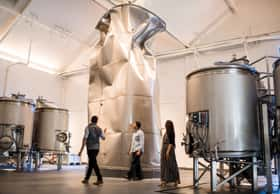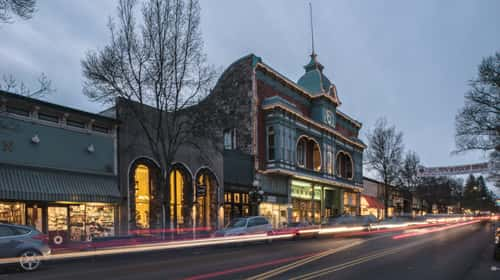One year after the Wine Country wildfires, both Sonoma and Napa are still suffering afterburn when it comes to tourism.
Normal
0
false
false
false
EN-US
JA
X-NONE
The old adage is that “perception is reality,” and that is keeping tourism officials busy as they work to convince tourists that Wine County didn’t evaporate in the fires and, despite what they might see on the news, not all of the state is on fire.
New advertising campaigns are being launched. Additional funds are being budgeted, and tourism teams are feathering out nationwide (and internationally) to spread the word—Wine County is open for business.
Looking back
The tourist industry’s journey since October 8, 2017, is truly a case study in crisis management for destination locations after a natural disaster. In short, crisis management meets “all systems go.”
The fires erupted at the height of tourist season—during harvest—and hotels were full. Once the severity of the situation was made clear, those whose livelihood was to draw tourists in found themselves in the unique position of getting tourists out, all while making sure their evacuated employees and neighbors, plus first responders fighting the flames, had accommodations. In fact, the hospitality industry played a major role after the fire. People displaced from the fires showed up in many hotel lobbies as places of rescue, says Claudia Vecchio, president and chief executive officer of Sonoma County Tourism (SCT). “And they jumped right in, feeding people for free. The tourism industry from Rohnert Park to Bodega Bay was basically unimpacted, but they did a spectacular job helping those in need,” she notes.
Strategically, Visit Napa Valley (VNV) had a leadership conference call first thing Monday morning, with the fires only 12 hours old, according to Lisa Poppen, vice president of marketing and communications. SCT initiated its strategic crisis management plan from the get-go, according to Vecchio, who initially participated from afar Nevada. She was director of the Nevada Department of Tourism and Cultural Affairs at the time.
Both agencies immediately pulled the plugs on their paid advertising campaigns going silent for weeks. With the news cycle as it was, says Poppen, we didn’t want standard messaging in the market. “It would be tone deaf to a crisis situation and a waste of budget to pay for an incongruent message during this time.”
“As a tourism bureau in a crisis area, our role was to think longer term to protect the integrity of the regions’ brand,” explains Poppen. “We need to protect the long-term integrity of our brand.” Turning off the advertising was crucial to that end.
In a unique partnership, VNV and SCT, which normally compete for tourists, developed a joint ad and participated together in Visit California promotional activities, including the Grateful Table event. The two organizations were key portals for conveying Cal Fire reports, road closures, and government sites such as FEMA. “We posted this information on the first day, and it was updated every one to two days as more information became available,” says Poppen.
VNV and SCT also collaborated behind the scenes, sharing updates and talking points, so both organizations were in sync with messaging. What’s more, they created a co-branded print advertising spread in the Wine Country section of the San Francisco Chronicle in November last year.
Calm after storm
Both SCT and VNV carefully monitored the situation as it evolved before making their next moves. Once the fires were fully contained and the air quality normalized (roughly between October 18 and the first week of November) the two groups began phase two of their efforts: getting the visitors to come back.
SCT launched its “Open for Business” campaign and VNV, working with the Sacramento-based advertising agency MeringCarson, introduced “Napa Valley Spirit.”
According to Poppen, the 2014 Napa earthquake gave VNV a bit of experience in crisis management, which they were able to utilize to the fullest when the fires hit.
“What was different about the earthquake was that it was over and done. We could immediately go out and confidently say, ‘Come back.’ With the fires, it was three weeks before they were officially contained and there were different conditions every day.” The five Napa Valley areas (American Canyon, Napa, Yountville, Oakville/Rutherford, St. Helena and Calistoga) all had disparate conditions. “Depending on the wind,” Poppen says, “Napa might have blue skies, while Calistoga was being evacuated.”
The VNV board and key stakeholders involved in approving the plan agreed it would launch only when air quality normalized, which began on October 18. For one month, it ran a print, radio, video, billboard, and social media campaign, welcoming visitors back. “Campaign messaging gave visitors permission to come and not feel guilty about having fun and drinking wine while people may have lost their homes,” Poppen says. Immediate focus was on the Bay Area drive area, she adds, because we knew they would return first.
“Tourism supports more than 13,000 jobs in Napa County. We wanted people to know the best way they could help recovery was to come visit. Our message was that visiting helps everyone rebuild,” Poppen says.
“Napa Valley Spirit” cost VNV an extra 10 percent of its annual advertising budget. It resulted in 11.5 million paid impressions, which was doubled by donated media, Poppen says.
SCT ramped up its advertising, spending an additional $500,000, which the SCT board of directors took from its reserves. Its campaign started the first week in November to support the economy and generate visitation, according to Sonoma County Tourism.
In Sonoma, the first order of business was to “communicate and educate about the realities and to correct rampant misperceptions,” Vecchio says. Sonoma County is roughly 1,700 square miles “and the reality is that only 10 percent of it burned,” Vecchio explains.
In addition to traditional advertising, SCT purchased additional digital advertising and perfected a sales outreach program. It invited press into the market and paid for familiarization trips for meeting planners. It also instituted incentives for meeting planners, providing cash toward hotel master bills to lure the business. “What we heard loud and clear was that they wanted to support us,” Vecchio says.
 SCT also started a program called “Sonoma Explorer,” encouraging visitors to get out and about in the county. This was a direct response to a new complexity in Sonoma’s tourism industry that emerged last fall, once the flames died down. “Hotels, especially along the Highway 101 corridor, were filled with evacuees and construction workers,” Vecchio explains. But the businesses off the beaten path—bed-and-breakfast inns, wineries and tasting rooms—“were very much impacted.” A year later, these businesses are still in recovery mode and “definitely down year-over-year.” As of this writing, Vecchio says there is no comprehensive report to confirm what they are experiencing.
SCT also started a program called “Sonoma Explorer,” encouraging visitors to get out and about in the county. This was a direct response to a new complexity in Sonoma’s tourism industry that emerged last fall, once the flames died down. “Hotels, especially along the Highway 101 corridor, were filled with evacuees and construction workers,” Vecchio explains. But the businesses off the beaten path—bed-and-breakfast inns, wineries and tasting rooms—“were very much impacted.” A year later, these businesses are still in recovery mode and “definitely down year-over-year.” As of this writing, Vecchio says there is no comprehensive report to confirm what they are experiencing.
In Napa Valley, VNV reports that during October when hotel occupancy rates generally hover around 80 percent, experienced a slip to only 60 percent in 2017. It didn’t pick up until December. “But a significant number of those were displaced residents (from the fire), and contract business such as PG&E workers and insurance adjusters,” Poppen says.
VNV’s fiscal year runs from July 1 to June 31. While October 2017 showed a 30 percent drop in revenue, the year in total was down only 1.2 percent.
Since 2015, Napa has added nine new hotel/inn properties with 608 additional hotel rooms.
“What we are seeing in the current market is that demand hasn’t kept up with the new supply,” Poppen says. “So hotels are having to make occupancy and rate decisions” which impact revenues.
Reverberations going forward
As the old saying goes, there’s no such thing as bad publicity. Poppen and Vecchio might beg to differ.
“When the nightly news comes on and you’re the lead story, it’s hard,” says Poppen, referring to continuous reporting of the fires on major networks. “They [reporters] don’t come back in front of a blue sky and say everything is now great.”
However, Vecchio notes that coverage did spotlight the county. “The awareness level of Sonoma County skyrocketed during the fires,” and SCT’s job is to “maximize that awareness, even though it was negative.”
The problem is that, overall, tourists outside the Bay Area—and to a greater extent, California—still have “smoke in their eyes” when it comes to visiting Sonoma, Napa or the state in general.
“The perception is still there and the fires over the summer exacerbated the idea,” Vecchio says. “People across the country have the perception that all of California is on fire, so they are going elsewhere.”
“It’s human nature to choose to go somewhere else,” Poppen says. “A vacation is an investment in money and time,” and even if tourists are reassured things are well, they aren’t sure if they trust it.
According to Poppen, this is particularly true for tourists who visit from farther away. “For six months we were talking to travel agents and other people who believed that [Wine Country] completely burned down,” she says.
As part of its partnership to draw visitors back into the fold, VNV and SCT took their show on the road to Los Angeles, Phoenix, Sacramento, San Francisco, Chicago, Texas and other major tourism shows to promote what was new and happening in the counties.
The tourism industry experienced another setback in June and July. Several fires erupted across the state, including Lake and Mendocino counties. The Mendocino Complex fire, which burned more than 400,000 acres, became the largest wildfire in California’s history.
“To people watching the news, it seemed as if the whole state was on fire. Though the fires weren’t in Napa County, it retriggered people not to come west,” Poppen says. She notes that the California Office of Tourism estimates that in July alone, the state lost $20 million in tourism revenue due to visitors’ concerns.
“The Governor [Jerry Brown] says it’s the new normal, like hurricane season in Florida,” Poppen says. “It’s our responsibility to arm visitors with information to understand fire season and what it means and doesn’t mean. There is still the opportunity to come and have a great vacation despite what you see on the news. It’s a vast state, with lots of land, and most of it is untouched by fire.”
Winter re-boot

This winter both VNV and SCT will focus on promoting the off-season, which historically runs from November through April. Fortunately, publicity efforts will return to normal programs, not fire recovery.
VNV began ramping up advertising for “Cabernet Season” on November 1, the same date SCT launched its new brand: “Sonoma County—Life Opens Up,” developed in conjunction with MMGY Global, a travel and hospitality marketing firm. The SCT tag line is a play on the concept that wine “opens up” once in the glass.
Going forward, VNV is placing an added focus on promoting its hotels, helping them to strategically grow demand.
“We’ll reach out to new audiences and encourage visitors to stay longer, so the tourism economy sees healthy growth and the county can benefit from increased tax revenue,” says Poppen.
Vecchio says SCT’s new branding effort is targeted at repositioning the county and the mindset in a “more exciting and compelling way” that will help move through fire obstacles.
“Our message is that there has never been a better time to come to Sonoma County. It’s always been an extraordinary destination. Getting past harvest time, winemakers are in their tasting rooms where they can interact directly with visitors,” she explains. “Winter is a magical time to be in Sonoma County.”
As far as last year’s fires are concerned, “Most visitors will never see the damage,” Vecchio says. “Those that do go to damaged areas will see rebuilding. They will witness the resilience and spirit of Sonoma County like never before.”




